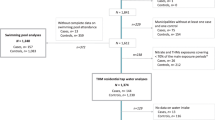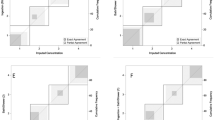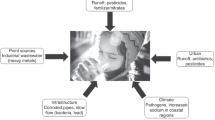Abstract
Trihalomethanes (THMs) can form as byproducts during drinking water disinfection, which is crucial for limiting human exposure to disease-causing pathogens. The US Environmental Protection Agency (USEPA), recognizing both the importance of water disinfection for public health protection and potential risks associated with THM exposure, developed disinfection byproduct rules with the parallel goals of ensuring safe drinking water and limiting the levels of THMs in public water systems. The National Health and Nutrition Examination Survey (NHANES) THM blood data can be used as a means for assessing US population exposures to THMs; biomonitoring equivalents (BEs) can provide human health risk-based context to those data. In this paper, we examine the blood THM levels in the 1999–2004 NHANES data to (i) determine weighted population percentiles of blood THMs, (ii) explore whether gender and/or age are associated with blood THM levels, (iii) determine whether temporal trends can be discerned over the 6-year timeframe, and (iv) draw comparisons between population THM blood levels and BEs. A statistically significant decrease in blood chloroform levels was observed across the 1999–2004 time period. Age-related differences in blood chloroform levels were not consistent and no gender-related differences in blood chloroform levels were observed. The concentrations of all four THMs in the blood of US residents from the 2003 to 2004 NHANES dataset are below BEs consistent with the current US EPA reference doses. For bromodichloromethane and dibromochloromethane, the measured median blood concentrations in the United States are within the BEs for the 10−6 and 10−4 cancer risk range, whereas measured values for bromoform generally fall below the 10−6 cancer risk range. These assessments indicate that general population blood concentrations of THMs are in a range considered to be a low to medium priority for risk assessment follow-up, according to the guidelines for interpretation of biomonitoring data using BEs.
This is a preview of subscription content, access via your institution
Access options
Subscribe to this journal
Receive 6 print issues and online access
$259.00 per year
only $43.17 per issue
Buy this article
- Purchase on Springer Link
- Instant access to full article PDF
Prices may be subject to local taxes which are calculated during checkout

Similar content being viewed by others
References
Ashley D.L., Bonin M.A., Cardinali F.L., McCraw J.M., and Wooten J.V. Blood concentrations of volatile organic compounds in a nonoccupationally exposed US population and in groxups with suspected exposure. Clin Chem 1994: 40 (7): 1401–1404.
Ashley D.L., Blount B.C., Singer P.C., Depaz E., Wilkes C., Gordon S., Lyu C., and Masters J. Changes in blood trihalomethane concentrations resulting from differences in water quality and water use activities. Arch Environ Occup Health 2005: 60: 7–15.
Aylward L.L., LaKind J.S., and Hays S.M. Biomonitoring Equivalents (BE) dossier for trihalomethanes. Regul Toxicol Pharmacol 2008: 51 (3 Suppl): S68–S77.
Bonin M.A., Silva L.K., Smith MM Ashley D.L., and Blount B.C. Measurement of trihalomethanes and methyl tert-butyl ether in whole blood using gas chromatography with high-resolution mass spectrometry. J Anal Toxicol 2005: 29 (2): 81–89.
Bove F., Shim Y., and Zeitz P. Drinking water contaminants and adverse pregnancy outcomes: a review. Environ Health Perspect 2002: 110 (Suppl 1): 61–74.
CDC (Centers for Disease Control and Prevention). Second National Report on Human Exposure to Environmental Chemicals. Division of Laboratory Sciences. Atlanta, GA, 2003.
CDC (Centers for Disease Control and Prevention). Third National Report on Human Exposure to Environmental Chemicals. Division of Laboratory Sciences. Atlanta, GA. http://www.cdc.gov/exposurereport/report.htm, 2005.
CDC (Centers for Disease Control and Prevention). Analytic And Reporting Guidelines. The National Health and Nutrition Examination Survey (NHANES). National Center for Health Statistics Centers for Disease Control and Prevention. Hyattsville, Maryland, September. http://www.cdc.gov/nchs/data/nhanes/nhanes_03_04/nhanes_analytic_guidelines_dec_2005.pdf, 2006.
Chamberlain G., and Imbens G.W. Nonparametric applications of bayesian inference. J Business Econ Stat 2003: 21 (1): 12–18.
Haddad S., Tardif G.C., and Tardif R. Development of physiologically based toxicokinetic models for improving the human indoor exposure assessment to water contaminants: trichloroethylene and trihalomethanes. J Toxicol Environ Health A 2006: 69: 2095–2136.
Harrell E. Jr, et al. Hmisc: Harrell Miscellaneous. R package version 3.5-2. http://biostat.mc.vanderbilt.edu/s/Hmisc, http://biostat.mc.vanderbilt.edu/twiki/pub/Main/RS/sintro.pdf, http://biostat.mc.vanderbilt.edu/twiki/pub/Main/StatReport/summary.pdf, http://biostat.mc.vanderbilt.edu/trac/Hmisc, 2008.
Hays SM, Becker RA, Leung HW, Aylward LL, and Pyatt DW Biomonitoring equivalents: a screening approach for interpreting biomonitoring results from a public health risk perspective. Regul Toxicol Pharmacol 2007: 47 (1): 96–109.
Hays S.M., Aylward L.L., LaKind J.S., Bartels M.J., Barton H.A., Boogaard P.J. Brunk C., DiZio S., Dourson M., Goldstein D.A., Lipscomb J., Kilpatrick M.E., Krewski D., Krishnan K., Nordberg M., Okino M., Tan Y.M., Viau C., and Yager J.W. Guidelines for the Derivation of Biomonitoring Equivalents: Report from the Biomonitoring Equivalents Expert Workshop. Reg Toxicol Pharmacol 2008: 51 (3 Suppl): S4–15.
LaKind J.S., Aylward L.L., Brunk C., DiZio S., Dourson M., Goldstein D.A., Kilpatrick M.E., Krewski D., Bartels M.J., Barton H.A., Boogaard P.J., Lipscomb J., Krishnan K., Nordberg M., Okino M., Tan Y.M., Viau C., Yager J.W., and Hays S.M. Guidelines for the Communication of Biomonitoring Equivalents: Report from the Biomonitoring Equivalents Expert Workshop. Reg Toxicol Pharmacol 2008: 51 (3 Suppl): S16–S26.
R Development Core Team. R: A language and environment for statistical computing. R Foundation for Statistical Computing. Vienna, Austria, ISBN 3-900051-07-0, URL http://www.R-project.org, 2008.
Sohn M.D., McKone T.E., and Blancato J.N. Reconstructing population exposures from dose biomarkers: inhalation of trichloroethylene (TCE) as a case study. J Expo Anal Environ Epidemiol 2004: 14: 204–213.
Tan Y.M., Liao K.H., Conolly R.B., Blount B.C., Mason A.M., and Clewell H.J. Use of a physiologically based pharmacokinetic model to identify exposures consistent with human biomonitoring data for chloroform. J Toxicol Environ Health A 2006: 69: 1727–1756.
Tan Y.M., Liao K.H., and Clewell H.J. Reverse dosimetry: interpreting trihalomethanes biomonitoring data using physiologically based pharmacokinetic modeling. J Expo Sci Environ Epidemiol 2007: 17 (7): 591–603.
Tardiff R.G., Carson M.L., and Ginevan M.E. Updated weight of evidence for an association between adverse reproductive and developmental effects and exposure to disinfection by-products. Regul Toxicol Pharmacol 2006: 45 (2): 185–205.
USEPA. Implementation Guidance for the Stage 1 Disinfectants/Disinfection Byproducts Rule, Office of Water EPA 816-R-01-012. June 2001 Available: http://www.epa.gov/safewater/mdbp/s1dbprimplguid.pdf 2001.
USEPA. Drinking Water Criteria Document for Brominated Trihalomethanes, Office of Water EPA-822-R-05-11. 2005.
USEPA. 40 CFR Parts 9, 141, and 142 National Primary Drinking Water Regulations: Stage 2 Disinfectants and Disinfection Byproducts Rule; Final Rule. Available: http://www.epa.gov/fedrgstr/EPA-WATER/2006/January/Day-04/w03.pdf, 2006a.
USEPA. Stage 2 Disinfectants and Disinfection Byproduct Rule (Stage 2 DBP rule). Available: http://www.epa.gov/safewater/disinfection/stage2/basicinformation.html#ten, 2006b.
USEPA. Integrated Risk Information System. Chloroform, last updated on Wednesday, March 8th, 2006. Available: http://www.epa.gov/iris/subst/0025.htm, 2006c.
USEPA. Concepts, Methods and Data Sources for Cumulative Health Risk Assessment of Multiple Chemicals, Exposures and Effects: A Resource Document, ORD, NCEA, Cincinnati, OH. EPA/600/R-06/013f 2007.
USEPA. Integrated Risk Information System (IRIS), Chloroform (CASRN 67-66-3). http://www.epa.gov/NCEA/iris/subst/0025.htm, 2008.
Windham G.C., Waller K., Anderson M., Fenster L., Mendola P., and Swan S. Chlorination by-products in drinking water and menstrual cycle function. Environ Health Perspect 2003: 111 (7): 935–941.
Acknowledgements
We thank Dr. Lalith Silva and Mitchell Smith for analysis of thousands of NHANES blood samples to generate the published dataset. The findings and conclusions in this report are those of the authors and do not necessarily represent the views of the CDC nor of ACC. Mention of trade names or commercial products does not constitute endorsement or recommendation for use.
Author information
Authors and Affiliations
Corresponding author
Ethics declarations
Competing interests
Dr LaKind, Mr. Hays and Ms. Aylward received support for this research from the American Chemistry Council (ACC). Additional support was provided by the Centers for Disease Control and Prevention (CDC). ACC was not involved in the design, collection, management, analysis or interpreatation of the data; or in the preparation or approval of the manuscript.
Rights and permissions
About this article
Cite this article
Lakind, J., Naiman, D., Hays, S. et al. Public health interpretation of trihalomethane blood levels in the United States: NHANES 1999–2004. J Expo Sci Environ Epidemiol 20, 255–262 (2010). https://doi.org/10.1038/jes.2009.35
Received:
Accepted:
Published:
Issue Date:
DOI: https://doi.org/10.1038/jes.2009.35
Keywords
This article is cited by
-
Bayesian inference of chemical exposures from NHANES urine biomonitoring data
Journal of Exposure Science & Environmental Epidemiology (2022)
-
Realist review of policy intervention studies aimed at reducing exposures to environmental hazards in the United States
BMC Public Health (2016)
-
The influence of physicochemical properties on the internal dose of trihalomethanes in humans following a controlled showering exposure
Journal of Exposure Science & Environmental Epidemiology (2013)
-
Daily intake of bisphenol A and potential sources of exposure: 2005–2006 National Health and Nutrition Examination Survey
Journal of Exposure Science & Environmental Epidemiology (2011)



